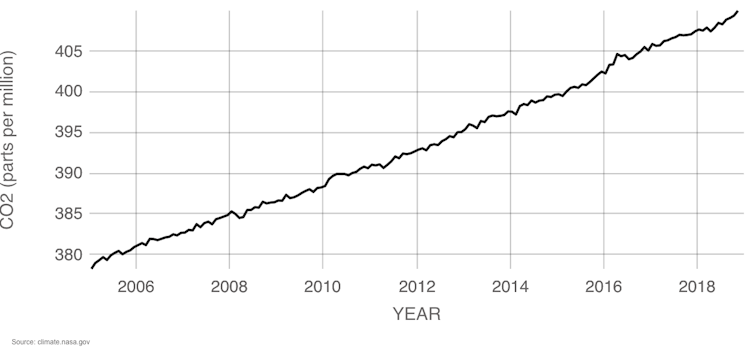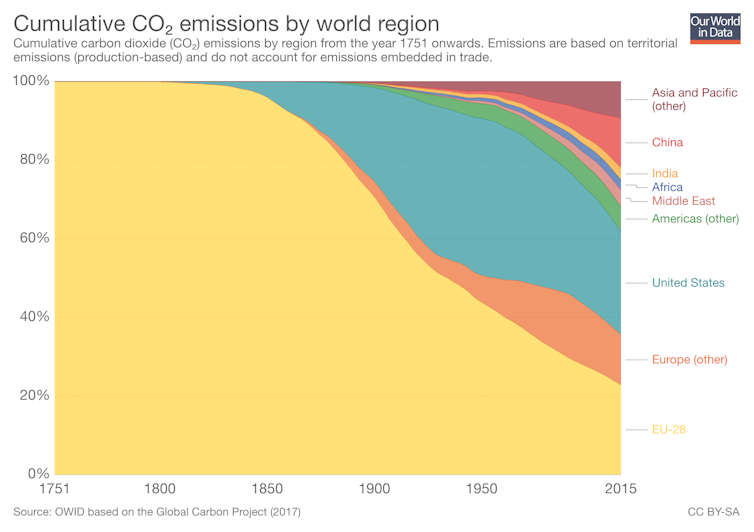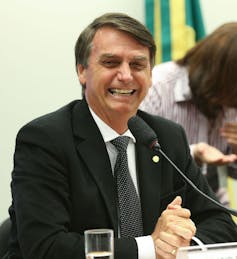An economist's take on the Poland climate conference: The glass is more than half full
- Written by Robert Stavins, Professor of Business and Government, Harvard University
The global climate change conference in Katowice, Poland[1], that wrapped up on Dec. 15 had a challenging mission. Three years ago in Paris, 196 countries and regions agreed to curb global greenhouse gas emissions[2] Now they had to agree on rules and guidelines for how to do it.
Two urgent realities hung over the negotiations. First, U.S. President Donald Trump announced in June 2017 that the United States would withdraw from the Paris agreement in November 2020 – the soonest that any nation can actually do so. Second, although countries that are responsible for 97 percent of global greenhouse gas emissions have pledged to make cuts, the initial reductions will surely not be enough[3] to keep global warming below two degrees Celsius. So, a key question is how the Paris agreement can facilitate increased ambition over time.
Delegates in Poland wanted to make progress by filling in details of the skeletal Paris agreement. Was the meeting a success? A simple yes or no would be misleading. But from my perspective leading a delegation from the Harvard Project on Climate Agreements[4] at the conference, there were were significant gains in two key areas.
Nations agreed on uniform rules for measuring and reporting their own performance in cutting emissions. There also were intensive discussions of how to connect reduction efforts across regions, nations and sub-national areas, which offers many economic and other benefits. Even though the latter issue was not resolved in Katowice, I see the final agreement as a glass that is more than half full.
 Atmospheric carbon dioxide levels measured at Mauna Loa Observatory, Hawaii.
NOAA[5]
Atmospheric carbon dioxide levels measured at Mauna Loa Observatory, Hawaii.
NOAA[5]
One set of counting rules
As I wrote in 2015 when it was signed, the Paris agreement was a major milestone[6]. In it, 195 countries plus the European Union – accounting for 97 percent of global emissions – pledged to develop national targets and action plans for reducing their emissions. They also agreed to revise these contributions every five years, with an eye to ratcheting up their goals over time. In contrast, the predecessor international agreement, the Kyoto Protocol[7], covered only 14 percent of global emissions.
But the Paris agreement gave 154 developing countries significant wiggle room by granting them flexibility in determining how they would measure their emissions and track progress toward their national targets. For developing countries, this was important. Some lacked the capacity to accurately monitor their emissions, and others resisted being treated with the same rigor as industrialized countries. In their view this was unfair, since developed nations’ emissions were responsible for most of the warming that had occurred to date.
But now this has changed, thanks partly to close collaboration in Poland between the U.S. and Chinese delegations. These delegates worked closely to foster a remarkable consensus that all countries must follow uniform standards for measuring emissions and tracking the achievement of their national targets.
This was a significant accomplishment, and a major step toward a level playing field among nations. Such uniform treatment is essential for addressing the threat of climate change, because increases in emissions are mainly coming from the large emerging economies: China, India, Brazil, Korea, South Africa, Mexico and Indonesia.
Conceivably, this equal treatment could make it easier for the United States to remain in the Paris agreement if President Trump should become convinced that such action would be politically advantageous in the run-up to the 2020 presidential election. It also will create a path for a future Democratic or Republican administration to rejoin the Paris agreement if Trump follows through on his promise to withdraw.
 Wealthy nations account for most of the world’s cumulative carbon dioxide emissions since 1751, but large developing nations are becoming increasingly important sources.
OurWorldinData.org, CC BY-SA[8][9]
Wealthy nations account for most of the world’s cumulative carbon dioxide emissions since 1751, but large developing nations are becoming increasingly important sources.
OurWorldinData.org, CC BY-SA[8][9]
Linking policies across borders
A second key question was how the Paris agreement itself, as it was fleshed out, could enable and indeed facilitate more ambitious emissions cuts over time. One strategy is linking regional, national and sub-national climate change policies, so that emissions reductions in one jurisdiction can count toward another jurisdiction’s commitments.
This strategy often is characterized, somewhat inaccurately, as “carbon markets,” but it is broader than that. It could involve countries exchanging credits for their emissions reductions due to use of carbon taxes, cap-and-trade systems[10] or conventional performance standards, such as requiring power plants to emit no more than a certain amount of carbon dioxide per unit of electricity generation.
The existing linkage between cap-and-trade systems in California[11] and Quebec[12] is one example of such a connection. Under that link, firms in California can exchange emissions allowances with firms in Quebec and vice versa.
This approach can provide many benefits. It saves money because firms can take advantage of lower-cost opportunities to reduce emissions in other locations. And it improves operation of markets for carbon reductions by reducing the market power of dominant firms and the likelihood of price spikes. States, countries and regions can also benefit politically from working together.
 A month after climate change skeptic Jair Bolsonaro was elected president, Brazil reversed its plans to host the next UN climate conference in 2019. The meeting now will take place in Santiago, Chile.
Agência Brasil Fotografias/Wikimedia, CC BY[13][14]
A month after climate change skeptic Jair Bolsonaro was elected president, Brazil reversed its plans to host the next UN climate conference in 2019. The meeting now will take place in Santiago, Chile.
Agência Brasil Fotografias/Wikimedia, CC BY[13][14]
Most importantly, linkage satisfies a key criterion of the United Nations Framework Convention on Climate Change[15], that nations have “common but differentiated responsibilities” for cutting greenhouse gas emissions, with wealthy countries having greater responsibility for the accumulated stock of greenhouse gases in the atmosphere. Linking reduction policies means that nations can have very different ambitions in their national contributions to global efforts without sacrificing overall cost-effectiveness.
These strategies are likely to include very different types of national policies. As I have shown in work with Michael Mehling[16] and Gilbert Metcalf[17], linking such diverse policies is not simple[18], but in many cases is feasible.
Delegates in Poland sought to write guidelines for Article 6 of the Paris agreement, which guides such international cooperation. However, they were not able to reach agreement, due to objections from a single country – Brazil – and hence the issue was punted to the next conference, which will be held next year in Santiago, Chile.
This may not represent a failure, because linkages and exchanges under the Paris agreement can, in principle, proceed in the meantime. But without knowing what some potential future guidance and rules might bring, governments may hesitate to pursue bilateral linkages.
Ultimately, success or failure of the Paris agreement will depend upon national actions. And for that, it remains too soon to observe or even to predict the long-term outcome.
References
- ^ conference in Katowice, Poland (unfccc.int)
- ^ curb global greenhouse gas emissions (unfccc.int)
- ^ will surely not be enough (theconversation.com)
- ^ Harvard Project on Climate Agreements (www.belfercenter.org)
- ^ NOAA (climate.nasa.gov)
- ^ a major milestone (theconversation.com)
- ^ Kyoto Protocol (unfccc.int)
- ^ OurWorldinData.org (ourworldindata.org)
- ^ CC BY-SA (creativecommons.org)
- ^ cap-and-trade systems (theconversation.com)
- ^ California (www.arb.ca.gov)
- ^ Quebec (www.environnement.gouv.qc.ca)
- ^ Agência Brasil Fotografias/Wikimedia (commons.wikimedia.org)
- ^ CC BY (creativecommons.org)
- ^ United Nations Framework Convention on Climate Change (unfccc.int)
- ^ Michael Mehling (scholar.google.com.au)
- ^ Gilbert Metcalf (scholar.google.com)
- ^ is not simple (dx.doi.org)
Authors: Robert Stavins, Professor of Business and Government, Harvard University

